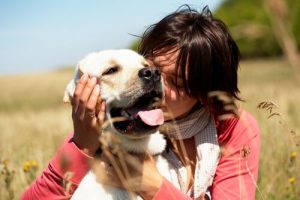5 Things Your Dog Doesn't Like

Dogs and humans have lived together for centuries. However, we must not forget that we’re different species. What follows is that if we want to understand them well, we need to learn interpret the different ways they try to communicate.
We also need to accept that what might be great to us may not be for them, and vice versa. So today we’ll tell you some things that your dog doesn’t like — and that you may be completely unaware of.
Learn how to recognize the things your dog doesn’t like
Barking is the most obvious way that dogs communicate, but they can also say a lot through their body language. In particular, they say a lot through moving their tail and ears.
Correctly decoding these signals is essential if you want to know what’s going on with your dog. It’ll help you be able to tell if they are scared, angry, happy, etc.
You can consult with a veterinarian or an animal behavior specialist to help understand your pet. Meanwhile, allow us to speak for them and tell you about certain things that your dog doesn’t like.
1-Hugs and other cuddles

Although we humans like to show affection by hugging one another, your four-legged friend doesn’t feel the same way. It’s important to realize this display of affection is actually immobilizing them. Your dog considers it an act of domination.
It’s quite probable, if you look carefully, that your dog is showing some signs of discomfort when you put your arms around them. Have you noticed these?
- Pulls their head away.
- Avoids eye contact.
- Licks their nose.
- Turns their ears back.
Also, if you’re used to patting your dog on the head or petting their face, you might have noticed that your dog closes their eyes or ducks their head. These are signs of submission.
2-Lack of clear rules
We all need basic rules to live together, and this is important for dogs as well as people. But if the rules are not perfectly clear or worse, contradictory, your dog will be confused and not know how to behave.
So don’t blame them if it results in behavioral problems. Isn’t it better to make sure everyone in the family knows and agrees with the rules? If one day you allow the dog to sit on the bed and the next day you don’t, they’ll at the very least be very confused.
3-Not letting them explore
Going for a walk is one of your dog’s favorite activities. But if you limit them to short walks, just so they can do their business, they’re not going to be very happy. As you know, dogs love to explore, and one of the most useful tools for exploring is their nose.
You can now see why it’s so important to let them to stick their nose in places — even if it looks and smells horrible to you. As we said, humans and dogs get along well, but they don’t like the same things. A perfume for you might smell exquisite, but be frankly unbearable for your dog.
4-Not paying them enough attention
When you decide to bring a pet into your life, it’s important to be aware of the responsibility that you’re taking on. More than just buying the best food or the most comfortable bed, your dog wants you to care for them and play with them!
Naturally, then, one thing your dog won’t like is not getting enough attention. A bored dog might destroy things in the house or urinate where they shouldn’t. If this happens, instead of scolding them, take a look at your own behavior first.
5-Humanizing them

The worst thing that you can to do your dog is to stop treating them for what they are: a dog. If you humanize your furry friend you increase their risk of all kinds of health and behavior problems. Respect your dog’s nature.
One of the many ways we humanize our pets is by dressing them in “fashionable” clothes. In fact, there is an entire industry catering to this madness. But dogs aren’t interested in designer clothes or expensive accessories.
All this does is make them uncomfortable and even cause skin problems. Remember, dogs only need one type of clothing, and it’s protective garments for the cold or rain.
This text is provided for informational purposes only and does not replace consultation with a professional. If in doubt, consult your specialist.